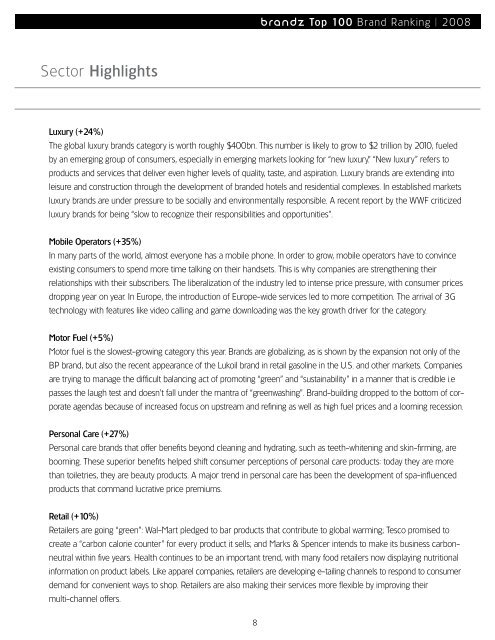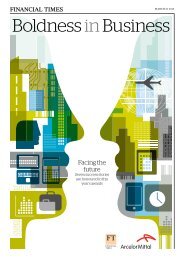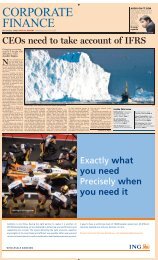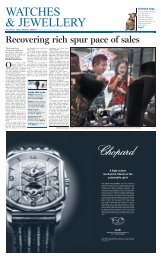BrandZ Top 100 2008 - WPP
BrandZ Top 100 2008 - WPP
BrandZ Top 100 2008 - WPP
You also want an ePaper? Increase the reach of your titles
YUMPU automatically turns print PDFs into web optimized ePapers that Google loves.
Sector Highlights<br />
BRANDZ <strong>Top</strong> <strong>100</strong> Brand Ranking | <strong>2008</strong><br />
Luxury (+24%)<br />
The global luxury brands category is worth roughly $400bn. This number is likely to grow to $2 trillion by 2010, fueled<br />
by an emerging group of consumers, especially in emerging markets looking for “new luxury.” “New luxury” refers to<br />
products and services that deliver even higher levels of quality, taste, and aspiration. Luxury brands are extending into<br />
leisure and construction through the development of branded hotels and residential complexes. In established markets<br />
luxury brands are under pressure to be socially and environmentally responsible. A recent report by the WWF criticized<br />
luxury brands for being “slow to recognize their responsibilities and opportunities”.<br />
Mobile Operators (+35%)<br />
In many parts of the world, almost everyone has a mobile phone. In order to grow, mobile operators have to convince<br />
existing consumers to spend more time talking on their handsets. This is why companies are strengthening their<br />
relationships with their subscribers. The liberalization of the industry led to intense price pressure, with consumer prices<br />
dropping year on year. In Europe, the introduction of Europe-wide services led to more competition. The arrival of 3G<br />
technology with features like video calling and game downloading was the key growth driver for the category.<br />
Motor Fuel (+5%)<br />
Motor fuel is the slowest-growing category this year. Brands are globalizing, as is shown by the expansion not only of the<br />
BP brand, but also the recent appearance of the Lukoil brand in retail gasoline in the U.S. and other markets. Companies<br />
are trying to manage the difficult balancing act of promoting “green” and “sustainability” in a manner that is credible i.e<br />
passes the laugh test and doesn’t fall under the mantra of “greenwashing”. Brand-building dropped to the bottom of corporate<br />
agendas because of increased focus on upstream and refining as well as high fuel prices and a looming recession.<br />
Personal Care (+27%)<br />
Personal care brands that offer benefits beyond cleaning and hydrating, such as teeth-whitening and skin-firming, are<br />
booming. These superior benefits helped shift consumer perceptions of personal care products: today they are more<br />
than toiletries, they are beauty products. A major trend in personal care has been the development of spa-influenced<br />
products that command lucrative price premiums.<br />
Retail (+10%)<br />
Retailers are going “green”: Wal-Mart pledged to bar products that contribute to global warming; Tesco promised to<br />
create a “carbon calorie counter” for every product it sells; and Marks & Spencer intends to make its business carbonneutral<br />
within five years. Health continues to be an important trend, with many food retailers now displaying nutritional<br />
information on product labels. Like apparel companies, retailers are developing e-tailing channels to respond to consumer<br />
demand for convenient ways to shop. Retailers are also making their services more flexible by improving their<br />
multi-channel offers.<br />
8
















